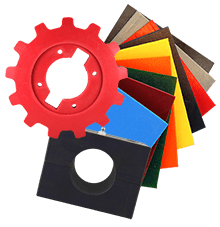Many industrial plastics can “overlap” in applications where sometimes the optimal choice is only marginally better than several others. Many plastics may work in an application, such as nylon and acetal for sheaves, but certain issues in the operational environment may mean you need to stay away from a certain plastic! Three of the most popular plastics we carry are UHMW polyethylene, cast nylon, and PTFE. But each of the following has a critical issue you need to know about that often discredits the material in certain applications.
UHMW – Impingement
UHMW is a great wear material at an affordable cost…Usually. The one place where it isn’t good at all is with impinging wear, that is wear from a mating partner (could be anything from grains, to rocks, to another sliding component). Impingement is when something hits that UHMW on an angle. With UHMW anything that is remotely abrasive needs to hit it on a 90 degree angle. If the angle is any sharper you risk very quick deterioration of the UHMW plastic. It simply does not hold up to impingement. Often polyurethane, which has excellent impingement resistance, is a substitute and one can be creative, for example only using polyurethane in the impact zone and use UHMW for the rest of the application.
Nylon – Cold Temperatures
Many people know that nylon is affected by moisture swell, what fewer people know is that it gets brittle in cold temperatures, about 10 Fahrenheit or -12 Celsius. This can come as a shock, as nylon is known as a high-load plastic able to handle 4,000 PSI in bearing applications. It is not intuitive to think that cold temperatures would greatly affect the nylon but it is true. Fortunately, replacements are available, specifically Redco Tuffkast is often best to replace nylon. Tuffkast solves not only cold weather issues with nylon but also absorbs much less moisture, so Tuffkast’s properties help in that case as well.
PTFE – Wear
It is often that customers request PTFE for a wear or lining application, even including heavy applications such as dump truck liners! We do try to warn them that PTFE has very poor wearing ability. It is a soft, almost waxy material, that while it is available in sheet form (and seems solid enough) it really cannot hold up to aggressive wear. Bronze filled PTFE is available which increases the wear capabilities; however, by that point there is often a less expensive, more available plastic, that can be suggested as a replacement. PTFE should be avoided in high wear applications wherever possible.
Hopefully you are surprised by at least one of those points, in the hopes that it will assist your material choice in your next application.
To discuss the optimal plastic for your application, get in touch with us today.

